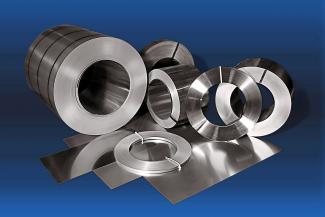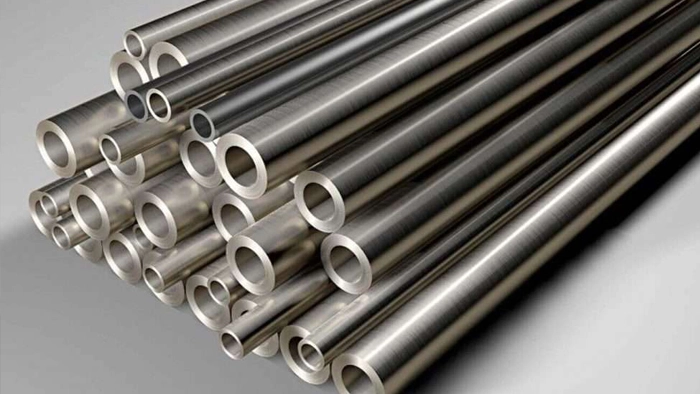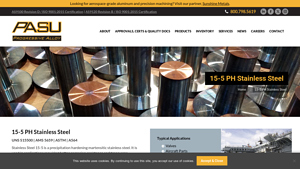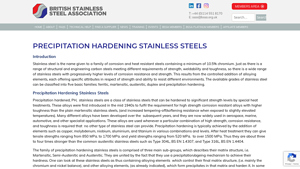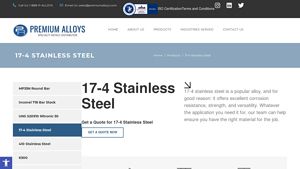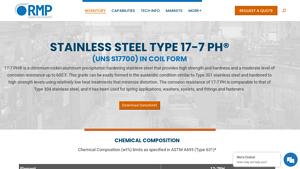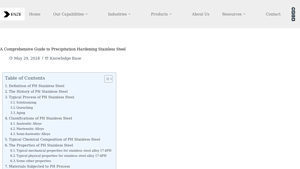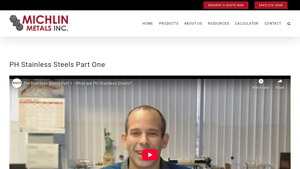Ph Stainless Steel Guide: Type, Cost, Top List…
Introduction: Navigating the Global Market for ph stainless steel
In today’s competitive landscape, sourcing high-quality PH stainless steel can be a complex challenge for international B2B buyers, particularly those in regions like Africa, South America, the Middle East, and Europe. With its unique properties—combining excellent corrosion resistance with remarkable strength—PH stainless steel is increasingly sought after for critical applications in aerospace, marine, and manufacturing industries. However, navigating the diverse grades, specifications, and suppliers requires a thorough understanding of the material’s characteristics and market dynamics.
This comprehensive guide delves into the various types of PH stainless steel, including martensitic, semi-austenitic, and austenitic grades, while also exploring their specific applications and performance advantages. We will provide actionable insights on how to effectively vet suppliers, assess costs, and ensure compliance with international standards. By equipping B2B buyers with the knowledge to make informed purchasing decisions, this guide aims to simplify the sourcing process and enhance the overall procurement strategy.
Whether you are looking to optimize your supply chain or enhance your product offerings, understanding the intricacies of PH stainless steel will empower you to make strategic decisions that drive value and innovation in your business. Let this guide be your trusted resource in navigating the global market for PH stainless steel, ensuring you secure the best materials for your specific needs.
Understanding ph stainless steel Types and Variations
| Type Name | Key Distinguishing Features | Primary B2B Applications | Brief Pros & Cons for Buyers |
|---|---|---|---|
| Martensitic PH Stainless Steel | High strength, single treatment process, good corrosion resistance | Aerospace components, pump parts, marine applications | Pros: High strength and hardness; Cons: Limited ductility. |
| Semi-Austenitic PH Stainless Steel | Good toughness, double treatment process, retains austenitic structure | Aerospace, automotive, and industrial applications | Pros: Excellent formability; Cons: Slightly lower strength than martensitic grades. |
| Austenitic PH Stainless Steel | Non-magnetic, retains austenitic structure even after aging | Food processing, chemical processing, and pharmaceutical sectors | Pros: Good corrosion resistance; Cons: Poor weldability. |
| Precipitation-Hardened Alloys | Contains copper, aluminum, or titanium; age-hardened for strength | High-performance components in various industries | Pros: Exceptional strength-to-weight ratio; Cons: Cost can vary based on specifications. |
| Custom Rolled PH Alloys | Tailored tempering process for specific applications | Specialized industries requiring precise material properties | Pros: Customized solutions; Cons: Longer lead times for production. |
What Are the Key Characteristics of Martensitic PH Stainless Steel?
Martensitic PH stainless steels, such as 17-4 PH, are characterized by their high strength and hardness achieved through a single treatment process. They undergo a solution annealing followed by rapid cooling, which retains essential alloying elements. This type is primarily used in aerospace and marine applications due to its impressive mechanical properties and moderate corrosion resistance. Buyers should consider the trade-off between strength and ductility, as this grade may exhibit limited formability.
How Do Semi-Austenitic PH Stainless Steels Differ in Performance?
Semi-austenitic PH stainless steels, like 17-7 PH, combine good toughness with the ability to undergo a double treatment process for enhanced strength. They maintain an austenitic structure, which allows for excellent cold forming capabilities. Commonly applied in aerospace and automotive industries, these steels offer a balance between strength and ductility. Buyers should note that while they provide good performance, their strength is typically lower than that of martensitic grades.
What Makes Austenitic PH Stainless Steel Suitable for Specific Industries?
Austenitic PH stainless steels, such as 17-10 PH, maintain a non-magnetic structure even after aging, making them suitable for applications in food processing and pharmaceuticals where corrosion resistance is critical. They offer good resistance to oxidation and a range of corrosive environments. However, their poor weldability can be a challenge, and buyers should ensure compatibility with welding processes to avoid issues during fabrication.
How Do Precipitation-Hardened Alloys Enhance Strength and Performance?
Precipitation-hardened alloys incorporate elements like copper or aluminum, which precipitate as hard compounds during the aging process, significantly enhancing hardness and strength. These alloys are ideal for high-performance components across various industries, including automotive and aerospace. While they offer an excellent strength-to-weight ratio, buyers should be aware that the cost can fluctuate based on the specific properties required for their applications.
Why Consider Custom Rolled PH Alloys for Specialized Applications?
Custom rolled PH alloys allow for tailored tempering processes, enabling manufacturers to achieve specific material properties for specialized applications. This flexibility is particularly beneficial for industries requiring precise mechanical attributes. However, buyers should factor in potential longer lead times for production, as custom solutions may take additional time to develop compared to standard grades.
Key Industrial Applications of ph stainless steel
| Industry/Sector | Specific Application of ph stainless steel | Value/Benefit for the Business | Key Sourcing Considerations for this Application |
|---|---|---|---|
| Aerospace | Aircraft components (landing gear, fuel tanks) | High strength-to-weight ratio, corrosion resistance | Compliance with aerospace standards (e.g., ASTM, AMS) |
| Marine | Marine hardware (shafts, pump parts) | Durability in harsh environments, reduced maintenance cost | Certifications for marine applications, corrosion resistance |
| Oil & Gas | Downhole tools and valves | Enhanced strength and reliability under pressure | Material traceability, adherence to industry standards |
| Medical Devices | Surgical instruments and implants | Biocompatibility, high strength for safety and longevity | ISO certifications, quality assurance testing |
| Automotive | High-performance components (bolts, fasteners) | Weight reduction, improved performance | Supplier reputation, lead times, and custom specifications |
How is PH Stainless Steel Utilized in the Aerospace Sector?
In the aerospace industry, PH stainless steel is essential for manufacturing components like landing gear and fuel tanks. Its exceptional strength-to-weight ratio allows for lightweight designs that enhance fuel efficiency. Additionally, its corrosion resistance ensures longevity and reliability in extreme environments. International buyers must ensure compliance with stringent aerospace standards, such as ASTM and AMS, to guarantee quality and performance in their applications.
What Role Does PH Stainless Steel Play in Marine Applications?
Marine hardware, including shafts and pump parts, benefits significantly from PH stainless steel due to its durability in corrosive seawater environments. This material minimizes maintenance costs and downtime, which is critical for marine operations. Buyers in this sector should prioritize sourcing from suppliers that offer certifications for marine applications and demonstrate high levels of corrosion resistance to ensure product longevity and reliability.
Why is PH Stainless Steel Important for the Oil & Gas Industry?
In the oil and gas sector, downhole tools and valves made from PH stainless steel provide enhanced strength and reliability under extreme pressure conditions. This material’s ability to withstand harsh environments is vital for operational safety and efficiency. Buyers should focus on sourcing materials with traceability and adherence to industry standards to mitigate risks associated with equipment failure and ensure compliance with safety regulations.
How is PH Stainless Steel Applied in Medical Devices?
PH stainless steel is widely used in medical devices, including surgical instruments and implants, due to its biocompatibility and high strength. These properties ensure that medical tools are safe for patient use while providing the necessary durability for repeated procedures. International buyers must consider ISO certifications and quality assurance testing when sourcing materials for medical applications to meet regulatory requirements and ensure patient safety.
What Advantages Does PH Stainless Steel Offer in the Automotive Industry?
In the automotive sector, PH stainless steel is utilized for high-performance components like bolts and fasteners, contributing to weight reduction and improved vehicle performance. Its superior strength allows for the design of lightweight yet robust parts that can withstand operational stresses. Buyers should evaluate supplier reputation, lead times, and the ability to meet custom specifications to ensure they receive quality materials that enhance their product offerings.
3 Common User Pain Points for ‘ph stainless steel’ & Their Solutions
Scenario 1: Inconsistent Quality in PH Stainless Steel Supply
The Problem:
B2B buyers often face the challenge of inconsistent quality when sourcing PH stainless steel. This inconsistency can arise from variations in the manufacturing processes of different suppliers, leading to discrepancies in the mechanical properties and corrosion resistance of the materials. Such issues can be particularly detrimental in industries like aerospace or marine applications, where the integrity of components is critical. A buyer might find that components fabricated from one batch of steel perform differently than those from another, resulting in costly rework, project delays, and potential safety risks.
The Solution:
To mitigate this problem, buyers should prioritize suppliers with a robust quality assurance system in place. Request detailed documentation of the supplier’s material certifications, including chemical composition and mechanical properties. Engage in regular audits of the supplier’s processes to ensure they adhere to industry standards such as ASTM or ISO certifications. Additionally, implementing a rigorous incoming quality control (IQC) process can help verify the steel’s properties before it is used in production. Consider establishing long-term partnerships with suppliers known for their consistency and reliability to streamline procurement and maintain quality over time.
Scenario 2: Difficulty in Welding PH Stainless Steel Components
The Problem:
Welding PH stainless steel can be a daunting task for many manufacturers due to its unique metallurgical properties. Buyers often encounter issues such as poor weldability, which can lead to cracking and reduced structural integrity in the final product. This is especially critical for applications that require high-strength joints, as even minor defects can lead to failures. Buyers may find themselves in a situation where their welding processes yield inconsistent results, leading to increased scrap rates and a need for rework, which ultimately affects the bottom line.
The Solution:
To address welding challenges, buyers should invest in comprehensive training for their welding teams on the specific requirements of PH stainless steels. This includes understanding the importance of pre-weld heat treatments and post-weld aging processes to enhance the performance of welded joints. Additionally, using the correct filler materials is crucial; opting for low-carbon or stabilized filler wires can prevent issues such as chromium carbide precipitation. Collaborating with welding engineers to develop detailed welding procedures tailored to the specific grade of PH stainless steel being used can also ensure consistent and high-quality welds.
Scenario 3: Misunderstanding the Aging Process of PH Stainless Steel
The Problem:
Many B2B buyers lack a clear understanding of the aging process required for precipitation-hardened (PH) stainless steel, which can lead to underperforming components. The aging treatment is essential for achieving the desired strength and hardness, and without proper execution, the materials may remain in a softer, more malleable state. This misunderstanding can result in components that do not meet performance specifications, leading to potential failures in their applications, increased warranty claims, and a tarnished reputation for the buyer’s products.
The Solution:
To overcome this challenge, buyers should invest in training and education on the aging process specific to the PH stainless steel grades they utilize. This includes understanding the temperature ranges and duration necessary for effective aging. Working closely with material scientists or metallurgists can provide insights into optimizing the aging parameters for specific applications. Furthermore, establishing a feedback loop with the heat treatment facilities can help ensure that the aging process aligns with production needs and quality standards. Implementing a systematic approach to monitor and document aging treatments can also aid in refining processes and achieving consistent results across all batches.
Strategic Material Selection Guide for ph stainless steel
What Are the Key Properties of Common PH Stainless Steel Materials?
Precipitation Hardening (PH) stainless steels are known for their unique blend of high strength and corrosion resistance. The following analysis covers three common materials used in PH stainless steel, focusing on their properties, advantages, disadvantages, and specific considerations for international B2B buyers.
1. 17-4 PH Stainless Steel
Key Properties: 17-4 PH is a martensitic stainless steel that offers excellent mechanical properties and corrosion resistance. It typically withstands temperatures up to 600°F (316°C) and exhibits good resistance to stress corrosion cracking.
Pros & Cons: The primary advantages of 17-4 PH include its high strength (up to 260 KSI) and good machinability. However, its weldability can be challenging, requiring careful control of heat input to avoid degradation of properties.
Impact on Application: This material is particularly suited for aerospace and marine applications, where high strength and corrosion resistance are critical. Its compatibility with various media makes it ideal for components like pump parts and valve bodies.
Considerations for International Buyers: Buyers in regions like Africa and the Middle East should ensure compliance with ASTM standards, as 17-4 PH is widely recognized. Additionally, understanding local manufacturing capabilities can help mitigate challenges related to welding.
2. 17-7 PH Stainless Steel
Key Properties: 17-7 PH is a semi-austenitic stainless steel that maintains good ductility and toughness, even after aging treatments. It can handle temperatures up to 800°F (427°C) and has excellent fatigue strength.
Pros & Cons: The key advantage of 17-7 PH is its ability to be cold-formed while still achieving high strength through aging. However, it can be more expensive than other grades due to its complex processing requirements.
Impact on Application: This material is ideal for applications requiring extensive forming and high strength, such as aerospace components and flexible bellows. Its excellent toughness also makes it suitable for high-stress environments.
Considerations for International Buyers: Buyers in Europe, particularly Germany, should consider the DIN standards for 17-7 PH. Additionally, the material’s higher cost may be a consideration for projects with tight budgets.
3. 15-5 PH Stainless Steel
Key Properties: 15-5 PH is another martensitic stainless steel known for its high strength and good corrosion resistance, particularly in acidic environments. It can withstand temperatures up to 600°F (316°C).
Pros & Cons: The advantages of 15-5 PH include its excellent toughness and resistance to corrosion, making it suitable for harsh environments. However, it may require more complex machining processes, which can increase production costs.
Impact on Application: This material is often used in the aerospace and chemical processing industries, where components are exposed to aggressive media. Its compatibility with various chemicals enhances its application scope.
Considerations for International Buyers: Buyers from South America should be aware of local regulations regarding corrosion-resistant materials. Compliance with ASTM standards is crucial for ensuring product reliability and performance.
Summary Table of PH Stainless Steel Materials
| Material | Typical Use Case for ph stainless steel | Key Advantage | Key Disadvantage/Limitation | Relative Cost (Low/Med/High) |
|---|---|---|---|---|
| 17-4 PH | Aerospace components, pump parts | High strength and good machinability | Challenging weldability | Medium |
| 17-7 PH | Aerospace components, flexible bellows | Excellent ductility and toughness | Higher cost due to complex processing | High |
| 15-5 PH | Aerospace, chemical processing | Excellent toughness and corrosion resistance | Complex machining increases costs | Medium |
This strategic material selection guide provides a comprehensive overview for B2B buyers considering PH stainless steel. Understanding the properties, advantages, and limitations of each material can aid in making informed purchasing decisions tailored to specific applications and regional requirements.
In-depth Look: Manufacturing Processes and Quality Assurance for ph stainless steel
What Are the Key Stages in the Manufacturing Process for PH Stainless Steel?
The manufacturing process for precipitation-hardening (PH) stainless steel involves several critical stages that ensure the material achieves the desired strength and corrosion resistance. Understanding these stages is vital for B2B buyers looking to procure high-quality PH stainless steel products.
How Is Material Prepared for PH Stainless Steel Production?
The first step in manufacturing PH stainless steel is material preparation, which typically involves the following processes:
-
Raw Material Selection: High-quality Fe-Cr-Ni alloys are chosen, with additional elements like copper, molybdenum, niobium, titanium, or aluminum to facilitate precipitation hardening.
-
Solution Annealing: The raw material undergoes a solution annealing process at high temperatures (around 1900-1950°F) to dissolve all alloying elements into a single-phase solution. This treatment enhances the material’s ductility and prepares it for subsequent processing.
-
Cold Working: After annealing, the material is cold worked to achieve the desired mechanical properties. This process can involve rolling, drawing, or other deformation techniques, which improve the strength and hardness of the material.
What Are the Key Techniques in Forming PH Stainless Steel?
Once the material is prepared, it proceeds to the forming stage, where various techniques are employed to shape it into its final form:
-
Blanking and Drawing: The cold-worked material is blanked and drawn into specific shapes, such as sheets, plates, or components. This step is crucial for producing parts that require precision and consistency.
-
Aging Treatment: Following the forming process, the parts undergo an aging treatment at temperatures between 900-1100°F. This heat treatment precipitates hardening compounds, significantly enhancing the strength and hardness of the material.
-
Final Forming Operations: Additional forming operations may be required to achieve the final specifications. These can include machining, bending, or welding, depending on the product’s intended application.
What Finishing Processes Are Commonly Used for PH Stainless Steel?
Finishing processes are essential for enhancing the surface quality and performance characteristics of PH stainless steel products:
-
Surface Treatment: Common surface treatments include pickling and passivation, which remove impurities and enhance corrosion resistance.
-
Inspection and Testing: Before final delivery, components undergo rigorous inspection and testing to ensure they meet specified standards. This may include dimensional checks, visual inspections, and non-destructive testing methods.
-
Packaging: Finally, the finished products are carefully packaged to prevent damage during transportation, ensuring they arrive in optimal condition.
What International Standards Guide Quality Assurance for PH Stainless Steel?
Quality assurance in the manufacturing of PH stainless steel is guided by various international standards, which are critical for B2B buyers seeking reliability and consistency:
-
ISO 9001: This widely recognized quality management standard ensures that manufacturers maintain effective quality management systems. Compliance with ISO 9001 signifies a commitment to continuous improvement and customer satisfaction.
-
Industry-Specific Standards: Depending on the application, other certifications may apply. For instance, the API (American Petroleum Institute) standards are relevant for materials used in the oil and gas sector, while CE marking is essential for products sold within the European market.
What Are the Quality Control Checkpoints in PH Stainless Steel Production?
Quality control is integral to the manufacturing process of PH stainless steel. Key checkpoints include:
-
Incoming Quality Control (IQC): Raw materials are inspected upon arrival to ensure they meet specified standards. This includes checking for chemical composition and physical properties.
-
In-Process Quality Control (IPQC): Continuous monitoring during the manufacturing process ensures that all stages adhere to quality standards. This may involve regular sampling and testing of materials at various stages.
-
Final Quality Control (FQC): The final products are subjected to comprehensive testing, including mechanical property assessments, corrosion resistance evaluations, and dimensional inspections to ensure they meet customer requirements.
How Can B2B Buyers Verify Supplier Quality Control Practices?
B2B buyers must ensure that their suppliers adhere to stringent quality control practices. Here are some effective strategies:
-
Supplier Audits: Conducting on-site audits of potential suppliers allows buyers to assess their manufacturing processes, quality control measures, and compliance with international standards firsthand.
-
Reviewing Quality Reports: Requesting documentation, including quality assurance reports and certifications, can provide insights into the supplier’s adherence to quality standards.
-
Third-Party Inspections: Engaging independent third-party inspection agencies can offer an unbiased assessment of the supplier’s quality control practices. These inspections can validate the supplier’s claims and ensure product integrity.
What Are the Nuances of Quality Certification for International B2B Buyers?
For B2B buyers, particularly those from diverse regions like Africa, South America, the Middle East, and Europe, understanding the nuances of quality certification is crucial:
-
Regional Compliance: Different regions may have specific compliance requirements. For example, European buyers may prioritize CE marking, while buyers in the Middle East may focus on local standards.
-
Traceability and Documentation: Buyers should ensure that suppliers provide complete traceability of materials used in production. This includes material certificates and test reports, which are critical for regulatory compliance.
-
Cultural Considerations: When dealing with international suppliers, cultural differences may influence quality expectations and communication styles. Understanding these differences can enhance collaboration and ensure alignment on quality goals.
Conclusion
Understanding the manufacturing processes and quality assurance standards for PH stainless steel is essential for B2B buyers seeking high-quality materials. By focusing on key stages of production, relevant international standards, and effective quality control measures, buyers can make informed decisions and establish reliable partnerships with suppliers across various regions.
Practical Sourcing Guide: A Step-by-Step Checklist for ‘ph stainless steel’
To assist B2B buyers in procuring PH stainless steel efficiently, this guide provides a structured checklist, ensuring that all critical aspects are covered. By following these steps, you can make informed decisions that align with your technical requirements and business objectives.
Step 1: Define Your Technical Specifications
Establishing clear technical specifications is the foundation of any procurement process. Determine the specific grades of PH stainless steel required, such as 17/4 PH or 17/7 PH, based on your application needs. Consider factors like strength, corrosion resistance, and the intended operating environment, as these will influence the performance of the material in your projects.
Step 2: Research Potential Suppliers
Conduct thorough research to identify suppliers that specialize in PH stainless steel. Look for companies with a proven track record in your industry, as they are more likely to understand the nuances of your requirements. Use industry forums, trade shows, and directories to compile a list of potential suppliers, ensuring they have the capability to meet your specific needs.
Step 3: Evaluate Supplier Certifications
Before finalizing any partnerships, verify that potential suppliers hold relevant certifications. Certifications such as ISO 9001 or AS9100 indicate adherence to quality management systems, which can significantly impact product consistency and reliability. Request documentation and assess their compliance with international standards, particularly for industries like aerospace or marine where quality is paramount.
Step 4: Request Material Samples
Before placing a bulk order, request samples of the PH stainless steel. This step allows you to evaluate the material’s quality and performance characteristics firsthand. Assess aspects such as hardness, ductility, and corrosion resistance to ensure they align with your specifications. Conduct any necessary testing to verify that the material will perform adequately in your intended application.
Step 5: Discuss Pricing and Terms
Engage in detailed discussions regarding pricing and payment terms with shortlisted suppliers. Understand the cost structure, including potential additional fees for custom processing or shipping. Negotiating favorable terms can lead to long-term savings, but ensure that price discussions do not compromise material quality or supplier reliability.
Step 6: Assess Lead Times and Logistics
Evaluate the lead times provided by suppliers for the delivery of PH stainless steel. Timeliness is crucial in maintaining your project schedules, so inquire about their production capabilities and inventory levels. Discuss logistics options, including shipping methods and costs, to ensure that your supply chain remains efficient and cost-effective.
Step 7: Establish Post-Purchase Support
After procurement, ensure that your supplier offers adequate post-purchase support. This can include assistance with material processing, welding recommendations, and troubleshooting any issues that arise during fabrication. A reliable supplier will provide ongoing support, which can be invaluable for optimizing your production processes and addressing any challenges.
By following this checklist, B2B buyers can systematically approach the procurement of PH stainless steel, ensuring that they select the right materials from reliable suppliers while aligning with their operational needs and quality standards.
Comprehensive Cost and Pricing Analysis for ph stainless steel Sourcing
What Are the Key Cost Components in PH Stainless Steel Sourcing?
When sourcing PH stainless steel, understanding the cost structure is crucial for making informed purchasing decisions. The main cost components include:
-
Materials: The primary cost driver, materials can vary significantly based on alloy composition, with elements like copper, niobium, and titanium influencing prices. The current market price of raw materials, including fluctuations due to geopolitical factors, directly impacts the overall cost of PH stainless steel.
-
Labor: Labor costs are affected by the complexity of the manufacturing process. Skilled labor is often required for tasks such as precision machining and heat treatment, which are essential for achieving the desired mechanical properties of PH stainless steel.
-
Manufacturing Overhead: This includes utilities, depreciation of machinery, and facility maintenance. Efficient manufacturing processes can help reduce overhead costs, making it vital to assess the operational efficiency of potential suppliers.
-
Tooling: Specialized tooling may be necessary for the production of PH stainless steel components. The cost of tooling can be significant, particularly for custom orders or specialized applications.
-
Quality Control (QC): Ensuring that products meet specified standards incurs costs related to testing, inspection, and certification. Buyers should verify that suppliers maintain rigorous QC procedures to ensure product reliability.
-
Logistics: Transportation and shipping costs can vary widely depending on distance, volume, and chosen Incoterms. Understanding logistics is crucial, especially for international buyers dealing with customs and tariffs.
-
Margin: Suppliers typically include a profit margin in their pricing, which can vary depending on the supplier’s market position and the competitive landscape.
How Do Price Influencers Affect PH Stainless Steel Costs?
Several factors influence the pricing of PH stainless steel, which buyers should consider:
-
Volume and Minimum Order Quantity (MOQ): Higher order volumes often lead to lower per-unit costs due to economies of scale. Buyers should negotiate MOQs to optimize pricing based on their needs.
-
Specifications and Customization: Custom specifications may incur additional costs for material formulation and processing. Buyers should clearly define their requirements to avoid unexpected expenses.
-
Materials and Quality Certifications: The grade and quality of the stainless steel, along with certifications (such as ISO), can affect pricing. Higher quality materials generally command a premium, but they also ensure better performance and longevity.
-
Supplier Factors: The reputation, experience, and location of suppliers can influence pricing. Established suppliers may offer better reliability but at a higher cost, while emerging suppliers may provide competitive pricing but with potential risks.
-
Incoterms: The choice of Incoterms affects the cost structure by defining the responsibilities of buyers and sellers regarding shipping, insurance, and tariffs. Understanding these terms can help buyers manage their total costs effectively.
What Are the Best Buyer Tips for Sourcing PH Stainless Steel?
To navigate the complexities of sourcing PH stainless steel, international buyers can employ several strategies:
-
Negotiation: Establishing a good relationship with suppliers can lead to better pricing and terms. Be prepared to negotiate based on volume, specifications, and long-term partnerships.
-
Cost-Efficiency: Focus on the Total Cost of Ownership (TCO), which includes not just the purchase price but also costs related to maintenance, durability, and performance. Investing in higher-quality materials can reduce long-term operational costs.
-
Understanding Pricing Nuances: International buyers should be aware of regional market dynamics. For instance, sourcing from suppliers in Europe may involve different pricing structures compared to those in Africa or South America, influenced by local production capabilities and material availability.
-
Research and Due Diligence: Conduct thorough research on potential suppliers, including their manufacturing processes, quality control measures, and customer reviews. This can help mitigate risks associated with subpar materials or services.
Disclaimer on Indicative Prices
Prices for PH stainless steel can vary significantly based on market conditions, supplier negotiations, and specific order requirements. Buyers are encouraged to obtain detailed quotations from multiple suppliers to ensure competitive pricing and optimal sourcing decisions.
Alternatives Analysis: Comparing ph stainless steel With Other Solutions
Introduction to Alternative Solutions for PH Stainless Steel
In the competitive landscape of industrial materials, B2B buyers often explore various alternatives to meet specific performance and cost requirements. Precipitation Hardening (PH) stainless steel stands out for its high strength and corrosion resistance, making it suitable for demanding applications. However, alternatives exist that may provide similar benefits with different characteristics, costs, or ease of implementation. This analysis compares PH stainless steel with two viable alternatives: martensitic stainless steel and aluminum alloys.
Comparison Table
| Comparison Aspect | PH Stainless Steel | Martensitic Stainless Steel | Aluminum Alloys |
|---|---|---|---|
| Performance | High strength (up to 260 KSI), good corrosion resistance | High strength, moderate corrosion resistance | Lightweight, good corrosion resistance, but lower strength |
| Cost | Moderate cost, potential for higher performance without significant price increase | Generally lower cost than PH steel | Varies, often lower than stainless steels |
| Ease of Implementation | Requires precise heat treatment and care in welding | Easier to work with, good weldability | Generally easy to fabricate and machine |
| Maintenance | Low maintenance if properly treated | Moderate maintenance, susceptible to corrosion if not treated | Low maintenance, but can corrode in certain environments |
| Best Use Case | Aerospace, marine, and high-stress components | General engineering, cutlery, and tools | Structural components, automotive parts, and consumer goods |
Detailed Breakdown of Alternatives
Martensitic Stainless Steel
Martensitic stainless steels, characterized by their high carbon content, offer excellent strength and hardness. They can achieve high hardness levels through quenching and tempering, making them suitable for tools and structural applications. However, they typically present moderate corrosion resistance compared to PH stainless steel, which may limit their use in highly corrosive environments. Their lower cost and easier workability make them attractive for manufacturers looking to balance performance with budget constraints.
Aluminum Alloys
Aluminum alloys are known for their lightweight properties, making them ideal for applications where weight savings are crucial, such as in the aerospace and automotive industries. They also exhibit good corrosion resistance due to the formation of a protective oxide layer. However, aluminum alloys generally have lower strength compared to PH stainless steel, which may necessitate thicker components to achieve the same load-bearing capacity. Their ease of fabrication and lower costs can make them a favorable choice for manufacturers prioritizing cost-effectiveness and lightweight solutions.
Conclusion: Choosing the Right Solution for Your Needs
When selecting a material solution, B2B buyers must consider specific application requirements, including strength, weight, corrosion resistance, and budget constraints. PH stainless steel is an excellent choice for high-performance applications where strength and corrosion resistance are critical. In contrast, martensitic stainless steel may be preferred for projects with less stringent corrosion requirements and where cost savings are a priority. Meanwhile, aluminum alloys can provide an ideal lightweight alternative for applications that do not demand the high strength of steel. Ultimately, understanding the trade-offs between these options will empower buyers to make informed decisions that align with their operational goals and budgetary limitations.
Essential Technical Properties and Trade Terminology for ph stainless steel
What Are the Key Technical Properties of PH Stainless Steel?
1. Material Grades
PH stainless steels are categorized into three main groups: martensitic, semi-austenitic, and austenitic. Each group has distinct properties and applications, with martensitic grades like 17-4 PH offering high strength and corrosion resistance, making them ideal for demanding environments. Understanding the specific grade needed for an application ensures optimal performance and longevity, which is crucial for manufacturers looking to reduce failure rates and maintenance costs.
2. Yield Strength
Yield strength measures the maximum stress a material can withstand before permanent deformation occurs. PH stainless steels can achieve yield strengths ranging from 1200 to 1790 MPa (175 to 260 KSI), surpassing traditional stainless steels. High yield strength is particularly important for components subjected to dynamic loads, such as aerospace parts, where failure can be catastrophic.
3. Hardness Levels
Hardness in PH stainless steels is a crucial property that reflects their resistance to deformation. These alloys can be heat-treated to achieve Rockwell hardness levels between C35 and C50. This property is vital for applications requiring wear resistance, such as cutting tools and automotive parts, ensuring that products maintain their integrity under harsh conditions.
4. Corrosion Resistance
While PH stainless steels maintain corrosion resistance comparable to Type 304 stainless steel, the aging process can slightly affect this property. Understanding the balance between strength and corrosion resistance is essential for B2B buyers, as choosing the right alloy for specific environments—like marine or chemical applications—can significantly impact product durability and performance.
5. Tolerance Levels
Tolerance refers to the allowable deviation from specified dimensions in manufacturing. In precision engineering, maintaining tight tolerances is critical, especially for parts that must fit together seamlessly. PH stainless steels can be fabricated to exacting tolerances, ensuring compatibility with other components and reducing the need for costly rework.
What Are Common Trade Terms Related to PH Stainless Steel?
1. OEM (Original Equipment Manufacturer)
An OEM is a company that produces parts or equipment that may be marketed by another manufacturer. Understanding OEM relationships is crucial for B2B buyers as it often impacts product quality, warranty terms, and after-sales support, influencing supply chain decisions.
2. MOQ (Minimum Order Quantity)
MOQ refers to the smallest number of units a supplier is willing to sell. This term is significant for buyers as it affects inventory management and cash flow. Knowing the MOQ helps businesses plan their purchases efficiently, ensuring they do not overstock or face shortages.
3. RFQ (Request for Quotation)
An RFQ is a document that solicits price proposals from suppliers for specific products or services. For B2B buyers, issuing RFQs is essential for comparing pricing, terms, and supplier capabilities, enabling informed purchasing decisions and fostering competitive pricing.
4. Incoterms (International Commercial Terms)
Incoterms are a set of predefined commercial terms published by the International Chamber of Commerce (ICC) that clarify the responsibilities of buyers and sellers in international transactions. Familiarity with Incoterms is vital for B2B buyers, as it defines who bears the risk and costs associated with shipping, insurance, and tariffs, ensuring smooth international trade.
5. Lead Time
Lead time is the amount of time it takes from placing an order to receiving the product. Understanding lead times is critical for buyers as it impacts project timelines and inventory levels. Effective management of lead times can lead to improved production schedules and customer satisfaction.
6. Certification Standards
Certification standards, such as ASTM or ISO, indicate that the material meets specific quality and safety benchmarks. For B2B buyers, ensuring that PH stainless steel products are certified is essential for compliance with industry regulations and customer requirements, enhancing trust and reliability in the supply chain.
Navigating Market Dynamics and Sourcing Trends in the ph stainless steel Sector
What Are the Current Market Dynamics and Key Trends Affecting PH Stainless Steel?
The global market for precipitation hardening (PH) stainless steel is experiencing notable growth, driven by increasing demand across various sectors, including aerospace, automotive, and marine industries. One of the primary drivers is the ongoing push for lightweight, high-strength materials that can withstand harsh environments while maintaining structural integrity. This demand is particularly evident in regions like Africa and South America, where infrastructural development is accelerating. Buyers from the Middle East and Europe, notably Germany and Vietnam, are also seeking advanced materials that offer superior performance without compromising on weight.
Emerging B2B technology trends are reshaping sourcing strategies in this sector. Digital procurement platforms are gaining traction, enabling buyers to efficiently compare suppliers, assess material quality, and negotiate pricing in real-time. Additionally, the rise of Industry 4.0 technologies, such as IoT and AI-driven analytics, is facilitating better inventory management and supply chain transparency. These innovations not only enhance operational efficiency but also empower buyers to make data-driven decisions regarding their sourcing strategies.
As sustainability becomes a critical focus for global businesses, the demand for eco-friendly materials is also impacting sourcing trends. International buyers are increasingly prioritizing suppliers that demonstrate a commitment to sustainable practices and ethical sourcing, particularly in the production of PH stainless steel. This shift is likely to reshape the competitive landscape, compelling manufacturers to adopt greener practices to meet buyer expectations.
How is Sustainability and Ethical Sourcing Shaping the PH Stainless Steel Market?
The environmental impact of stainless steel production, including PH alloys, has come under scrutiny as industries strive to reduce their carbon footprints. Ethical sourcing is no longer just a trend but a necessity for many B2B buyers. Companies are increasingly looking for suppliers that can demonstrate their commitment to sustainable practices, such as utilizing recycled materials and minimizing waste during manufacturing processes.
Green certifications, such as ISO 14001 for environmental management, are becoming vital for suppliers aiming to attract discerning international buyers. These certifications not only validate a supplier’s commitment to sustainability but also provide buyers with assurance that they are partnering with responsible manufacturers.
Moreover, the trend towards circular economy principles is gaining momentum, encouraging buyers to consider the entire lifecycle of materials. By sourcing PH stainless steel from suppliers who prioritize recycling and responsible waste management, companies can enhance their own sustainability credentials and reduce overall environmental impact. This focus on ethical sourcing is increasingly influencing procurement decisions across Africa, South America, the Middle East, and Europe, aligning with global sustainability goals.
What is the Brief Evolution and History of PH Stainless Steel in the B2B Sector?
Precipitation hardening stainless steel was developed in the mid-20th century as a response to the aerospace industry’s demand for materials that offered both high strength and corrosion resistance. Initially, the focus was on alloys that could withstand extreme conditions, which led to the formulation of various grades, including martensitic and semi-austenitic types.
As industries evolved, so did the applications of PH stainless steel, expanding into sectors such as automotive and medical devices. The ability to manufacture components in an annealed condition and subsequently harden them through aging treatments made these materials particularly appealing for complex geometries and high-performance applications.
Today, PH stainless steel is recognized for its versatility and strength, making it a preferred choice for international buyers looking for reliable materials that meet stringent performance standards. This evolution underscores the importance of continuous innovation and adaptation in meeting the dynamic needs of the B2B marketplace.
Frequently Asked Questions (FAQs) for B2B Buyers of ph stainless steel
-
How do I solve issues related to the corrosion resistance of PH stainless steel?
Corrosion resistance in PH stainless steel can be influenced by the aging process and the specific alloy composition. To address corrosion-related issues, ensure that the selected grade is appropriate for the intended application and environment. Consider applying protective coatings or surface treatments if the material will be exposed to harsh conditions. Regular maintenance and inspections can help identify early signs of corrosion, allowing for timely intervention. Consult with the supplier about specific grades known for enhanced corrosion resistance in your operational context. -
What is the best PH stainless steel grade for high-strength applications?
For high-strength applications, grades like 17-4 PH are often recommended due to their ability to achieve yield strengths up to 260 KSI after heat treatment. This grade is commonly used in industries such as aerospace, automotive, and marine, where strength and durability are paramount. Additionally, 17-7 PH offers good toughness and ductility for applications requiring extensive forming. Evaluate your specific requirements, including temperature resistance and corrosion exposure, to select the most suitable grade. -
How can I verify the quality of PH stainless steel from suppliers?
To ensure the quality of PH stainless steel, request material certification, which should include mechanical properties, chemical composition, and details of the heat treatment process. Conduct supplier audits to assess their manufacturing processes and quality control measures. Consider engaging third-party testing labs for independent verification of material properties. Establishing a long-term relationship with reputable suppliers can also facilitate consistent quality assurance. -
What are the minimum order quantities (MOQ) for PH stainless steel?
Minimum order quantities for PH stainless steel can vary significantly depending on the supplier and the specific grade. Generally, MOQs can range from a few hundred kilograms to several tons. It is advisable to discuss your needs directly with suppliers, as some may offer flexibility for smaller orders or might combine orders from multiple customers to meet MOQ requirements. Additionally, consider the cost implications of larger orders versus smaller, more frequent purchases. -
What payment terms should I expect when sourcing PH stainless steel internationally?
International payment terms for sourcing PH stainless steel typically include options such as letter of credit, advance payment, or open account terms, depending on the buyer-supplier relationship and country of origin. Ensure clarity on payment schedules, currency exchange rates, and any potential fees involved. Negotiate terms that protect both parties while ensuring timely transactions. Familiarize yourself with international trade regulations and payment practices in the supplier’s country to facilitate smoother negotiations. -
What logistics considerations should I keep in mind when importing PH stainless steel?
When importing PH stainless steel, consider factors such as shipping methods, customs clearance, and lead times. Collaborate with logistics providers experienced in handling metals to ensure efficient transportation. Familiarize yourself with import duties, taxes, and compliance with local regulations, which can impact overall costs. It may also be beneficial to establish a reliable supply chain network to mitigate delays and ensure consistent product availability. -
Can I customize PH stainless steel products to meet specific requirements?
Yes, many suppliers offer customization options for PH stainless steel products, including specific dimensions, surface finishes, and heat treatments. Clearly communicate your specifications and intended applications to the supplier to ensure they can meet your requirements. It’s advisable to work with manufacturers who have experience in customizing materials for your industry to ensure optimal performance and compliance with relevant standards. -
What are the common applications for PH stainless steel in various industries?
PH stainless steel is widely used in industries requiring high strength and corrosion resistance, such as aerospace, automotive, oil and gas, and marine applications. Common uses include components like fuel tanks, landing gear, pump parts, and fasteners. Its versatility allows for applications in both structural and high-stress environments. Understanding the specific needs of your industry can help in selecting the appropriate PH stainless steel grade and form for your projects.
Important Disclaimer & Terms of Use
⚠️ Important Disclaimer
The information provided in this guide, including content regarding manufacturers, technical specifications, and market analysis, is for informational and educational purposes only. It does not constitute professional procurement advice, financial advice, or legal advice.
While we have made every effort to ensure the accuracy and timeliness of the information, we are not responsible for any errors, omissions, or outdated information. Market conditions, company details, and technical standards are subject to change.
B2B buyers must conduct their own independent and thorough due diligence before making any purchasing decisions. This includes contacting suppliers directly, verifying certifications, requesting samples, and seeking professional consultation. The risk of relying on any information in this guide is borne solely by the reader.
Top 7 Ph Stainless Steel Manufacturers & Suppliers List
1. TWI – Precipitation Hardening Stainless Steels
Domain: twi-global.com
Registered: 2006 (19 years)
Introduction: Precipitation hardening (PH) stainless steels are corrosion resistant alloys with tensile strengths ranging from 850MPa to 1700MPa and yield strengths from 520MPa to over 1500MPa. They are used in industries such as oil and gas, nuclear, and aerospace, requiring high strength and corrosion resistance. Precipitation hardening is achieved through the addition of copper, molybdenum, aluminium, and ti…
2. Progressive Alloy – 15-5 PH Stainless Steel
Domain: progressivealloy.com
Registered: 2000 (25 years)
Introduction: 15-5 PH Stainless Steel UNS S15500 | AMS 5659 | ASTM A564
– Type: Precipitation hardening martensitic stainless steel
– Applications: Valves, Aircraft Parts, Gears, Pump Parts
– Mechanical Properties:
– H900: Ultimate Tensile Strength: 190,000 PSI, 0.2% Yield Strength: 170,000 PSI, Elongation: 10%, Reduction of Area: 40%, Hardness: Brinell 388, Rockwell C40
– H1025: Ultimate Tensile Strength: …
3. BSSA – Precipitation Hardening Stainless Steels
Domain: bssa.org.uk
Registered: 1997 (28 years)
Introduction: Precipitation Hardening Stainless Steels are a class of stainless steels that can achieve significant strength levels through special heat treatments. They were introduced in the mid-1940s for high strength, corrosion-resistant applications. Key features include:
– High strength levels: Tensile strengths range from 850 MPa to 1700 MPa; yield strengths from 520 MPa to over 1500 MPa.
– Composition: …
4. Premium Alloys – 17-4 Stainless Steel
Domain: premiumalloys.com
Registered: 2017 (8 years)
Introduction: 17-4 stainless steel is a popular alloy known for its excellent corrosion resistance, strength, and versatility. It contains about 17% chromium and 4% nickel, making it ideal for high temperature applications in industries such as gas, chemical, and aviation. The alloy exhibits mechanical properties, toughness, and strength even at temperatures up to 600 degrees Fahrenheit (316°C). It is frequentl…
5. Rolled Metal Products – Stainless Steel Type 17-7 PH®
Domain: rolledmetalproducts.com
Registered: 2000 (25 years)
Introduction: Stainless Steel Type 17-7 PH® (UNS S17700) is a chromium-nickel-aluminum precipitation hardening stainless steel that offers high strength and hardness with moderate corrosion resistance up to 600˚F. It can be easily formed in the austenitic condition and hardened with low heat treatments to minimize distortion. Its corrosion resistance is comparable to Type 304 stainless steel, making it suitable…
6. Enze MFG – Precipitation Hardening Stainless Steels
Domain: enzemfg.com
Registered: 2023 (2 years)
Introduction: Precipitation hardening (PH) stainless steels are corrosion-resistant alloys that can be heat treated to achieve tensile strengths ranging from 850 MPa to 1700 MPa and yield strengths from 520 MPa to over 1500 MPa. They are commonly used in industries such as nuclear, oil and gas, and aerospace, where high strength, good corrosion resistance, and acceptable toughness are required. The precipitatio…
7. Michlin Metals – PH Stainless Steels
Domain: michlinmetals.com
Registered: 1999 (26 years)
Introduction: PH Stainless Steels are a group of stainless steels known for high strength, excellent corrosion performance, and a simplified heat treatment process compared to conventional martensitic types. PH stands for “Precipitation Hardening,” which involves an initial solution treatment at high temperatures (typically 1900 degrees F) to uniformly distribute alloy elements within the metal structure. The r…
Strategic Sourcing Conclusion and Outlook for ph stainless steel
In the evolving landscape of manufacturing and materials, precipitation-hardening (PH) stainless steels stand out for their exceptional strength-to-weight ratios and versatility. B2B buyers should recognize that the unique metallurgical properties of PH stainless steels, including their ability to be fabricated in an annealed condition and subsequently hardened, present significant advantages in applications ranging from aerospace to marine components.
Strategic sourcing of PH stainless steel can lead to substantial cost savings while enhancing product performance. By leveraging partnerships with reliable suppliers who understand the nuances of various PH grades, businesses can ensure they meet specific application requirements while maintaining competitive pricing.
Looking ahead, the demand for high-performance materials like PH stainless steel is set to rise, particularly in emerging markets across Africa, South America, the Middle East, and Europe. Buyers are encouraged to engage with suppliers who offer tailored solutions and support for complex projects. By prioritizing strategic sourcing practices, international B2B buyers can position themselves to thrive in a competitive marketplace, driving innovation and ensuring long-term success.
